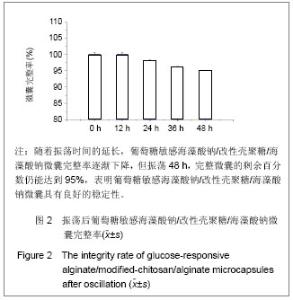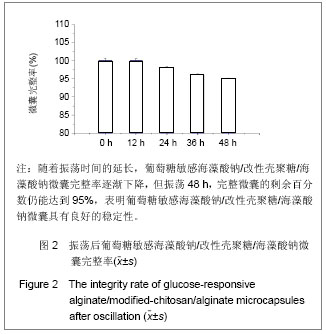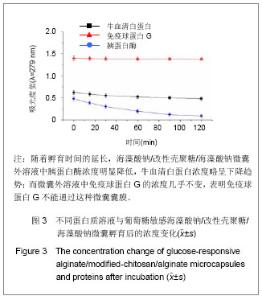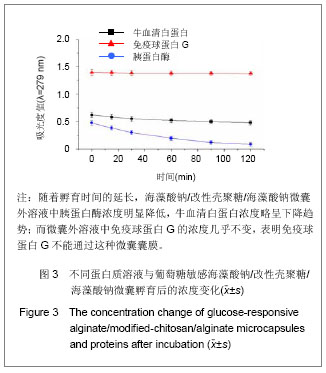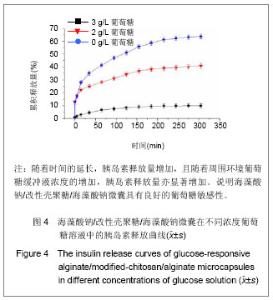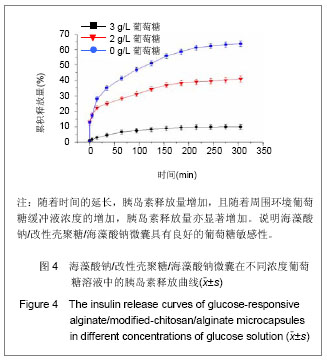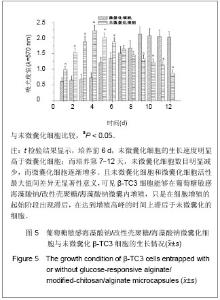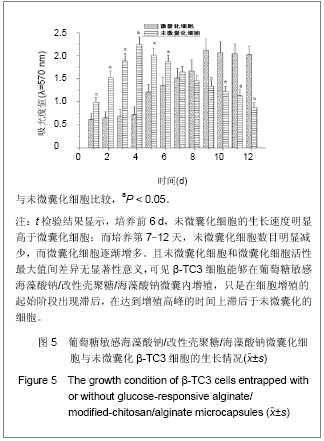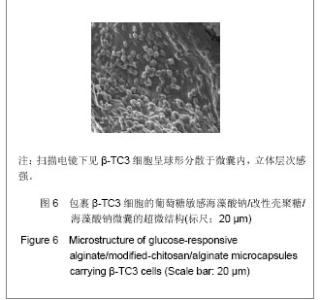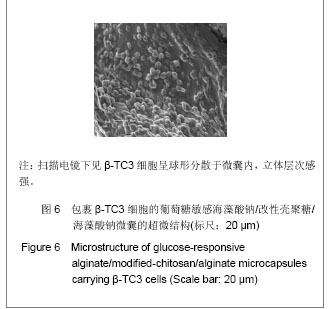Chinese Journal of Tissue Engineering Research ›› 2013, Vol. 17 ›› Issue (29): 5331-5336.doi: 10.3969/j.issn.2095-4344.2013.29.011
Previous Articles Next Articles
Biological characteristics of glucose-responsive microcapsules carrying beta-TC3 cells
Zhang Shao-min, Wu Zhong-ming, Yu De-min
- Metabolic Hospital of Tianjin Medical University, Key Laboratory of Hormones and Development, Ministry of Health, Tianjin 300070, China
-
Received:2013-04-16Revised:2013-05-07Online:2013-07-22Published:2013-07-22 -
Contact:Yu De-min, M.D., Doctoral supervisor, Metabolic Hospital of Tianjin Medical University, Key Laboratory of Hormones and Development, Ministry of Health, Tianjin 300070, China yudemin@hotmail.com -
About author:Zhang Shao-min★, Master, Metabolic Hospital of Tianjin Medical University, Key Laboratory of Hormones and Development, Ministry of Health, Tianjin 300070, China zhangshaomin1234@126.com -
Supported by:the National Natural Science Foundation of China, No. 81000683*
CLC Number:
Cite this article
Zhang Shao-min, Wu Zhong-ming, Yu De-min. Biological characteristics of glucose-responsive microcapsules carrying beta-TC3 cells[J]. Chinese Journal of Tissue Engineering Research, 2013, 17(29): 5331-5336.
share this article
| [1] Ludwig B, Rotem A, Schmid J, et al. Improvement of islet function in a bioartificial pancreas by enhanced oxygen supply and growth hormone releasing hormone agonist. Proc Natl Acad Sci U S A. 2012;109(13):5022-5027. [2] Teramura Y, Iwata H. Bioartificial pancreas microencapsulation and conformal coating of islet of Langerhans. Adv Drug Deliver Rev. 2010;62(7-8):827-840.[3] De Vos P, Van Straaten JF, Nieuwenhuizen AG, et al. Why do microencapsulated islet grafts fail in the absence of fibrotic overgrowth? Diabetes. 1999;48(7):1381-1388.[4] Chang TM. Artificial Cells for cell and organ replacements. Artif Organs. 2004;28(3):265-270.[5] Luo R, Li H, Lam KY. Modeling the effect of environmental solution pH on the mechanical characteristics of glucose-sensitive hydrogels. Biomaterials. 2009;30(4): 690-700.[6] Lee SJ, Park K. Synthesis and characterization of sol-gel phase-reversible hydrogels sensitive to glucose. J Mol Recognit. 1996;9(5-6):549-557.[7] Makino K, Mack EJ, Okano T, et al. Self-regulated delivery of insulin from microcapsules. Biomater Artif Cells Immobilization Biotechnol. 1991;19(1):219-228.[8] Tanna S, Joan Taylor M, Sahota TS, et al. Glucose-responsive UV polymerised dextran-concanavalin A acrylic derivatised mixtures for closed-loop insulin delivery. Biomaterials. 2006;27(8):1586-1597.[9] Cheng SY, Constantinidis I, Sambanis A. Use of glucose-responsive material to regulate insulin release from constitutively secreting cells. Biotechnol Bioeng. 2006;93(6): 1079-1088.[10] Wu Z, Zhang S, Zhang X, et al. Phenylboronic acid grafted chitosan as a glucose-sensitive vehicle for controlled insulin release. J Pharm Sci. 2011;100(6):2278-2286.[11] Huguet ML, Dellacherie E. Calcium alginate beads coated with chitosan: Effect of the structure of encapsulated materials on their release. Process Biochem. 1996;31(8): 745-751.[12] Hari PR, Chandy T, Sharma CP. Chitosan/calcium-alginate beads for intestinal delivery of nitrofurantoin. J Microencapsul. 1996;13(3):319-329.[13] Silva CM, Ribeiro AJ, Figueiredo IV, et al. Alginate microspheres prepared by internal gelation: Development and effect on insulin stability. Int J Pharm. 2006;311(1-2):1-10.[14] Mi FL, Sung HW, Shyu SS. Drug release from chitosan-alginate complex beads reinforced by a naturally occurring cross-linking agent. Carbohyd Polym. 2002;48(1): 61-72.[15] Pan XP, Li LJ. Advances in cell sources of hepatocytes for bioartificial liver. Hepatobiliary Pancreat Dis Int. 2012;11(6): 594-605.[16] 刘映薇,于炜婷,刘袖洞,等.海藻酸钠-壳聚糖-海藻酸钠(ACA)微胶囊的蛋白质通透性研究[J].中国生物医学工程学报,2006, 25(3):370-373.[17] 周晶,张英,王为,等.谷氨酰胺对微囊化重组CHO细胞生长代谢及内皮抑素表达的影响[J].生物工程学报,2006,22(1):162-166.[18] Lee CS, Chu IM. Characterization of modified alginate-poly-l-lysine microcapsules. Artif Organs. 1997; 21(9):1002-1006.[19] Dove A. Cell-based therapies go live. Nat Biotechnol. 2002; 20(4):339-343.[20] Kang J, Erdodi G, Kennedy JP, et al. Toward a bioartificial pancreas: diffusion of insulin and IgG across immunoprotective membranes with controlled hydrophilic channel diameters. Macromol biosci. 2010;10(4):369-377. [21] de Vos P, Spasojevic M, de Haan BJ, et al. The association between in vivo physicochemical changes and inflammatory responses against alginate based microcapsules. Biomaterials. 2012;33(22):5552-5559.[22] de Vos P, Faas MM, Strand B, et al. Alginate-based microcapsules for immunoisolation of pancreatic islets. Biomaterials. 2006;27(32):5503-5617.[23] Veriter S, Aouassar N, Adnet PY, et al. The impact of hyperglycemia and the presence of encapsulated islets on oxygenation within a bioartificial pancreas in the presence of mesenchymal stem cells in a diabetic Wistar rat model. Biomaterials. 2011;32(26):5945-5956. [24] Kitano S, Koyama Y, Kataoka K, et al. A novel drug delivery system utilizing a glucose responsive polymer complex between poly (vinyl alcohol) and poly (N-vinyl-2-pyrrolidone) with a phenylboronic acid moiety. J Control Release. 1992; 19(1-3):161-170.[25] Voigt A, Zintl F. Hybridoma cell growth and anti-neuroblastoma monoclonal antibody production in spinner flasks using a protein-free medium with microcarriers. J Biotechnol. 1999;68(2-3):213-226. |
| [1] | Chen Ziyang, Pu Rui, Deng Shuang, Yuan Lingyan. Regulatory effect of exosomes on exercise-mediated insulin resistance diseases [J]. Chinese Journal of Tissue Engineering Research, 2021, 25(25): 4089-4094. |
| [2] | Jiang Xiaoyan, Zhu Haifei, Lin Haiqi, Lin Wentao. Cold therapy promotes self-limited recovery of delayed-onset muscle soreness [J]. Chinese Journal of Tissue Engineering Research, 2021, 25(23): 3609-3613. |
| [3] | Xie Jingshu, Zhang Xianglin, Liu Jinlei, Wen Jing. Application of High Resolution reconstruction algorithm in precision CT scans of the middle and inner ears [J]. Chinese Journal of Tissue Engineering Research, 2021, 25(23): 3614-3618. |
| [4] | Liu Jinwei, Chen Yunzhen, Wan Chunyou. Changes of osteogenic growth factors in the broken end of bone nonunion under stress [J]. Chinese Journal of Tissue Engineering Research, 2021, 25(23): 3619-3624. |
| [5] | Luo Anyu, Liu Hanlin, Xie Xiaofei, Huang Chen. Effect of antioxidant mixture on structural degeneration of an osteoarthritis rat model [J]. Chinese Journal of Tissue Engineering Research, 2021, 25(23): 3625-3629. |
| [6] | Zhou Wu, Wang Binping, Wang Yawen, Cheng Yanan, Huang Xieshan. Transforming growth factor beta combined with bone morphogenetic protein-2 induces the proliferation and differentiation of mouse MC3T3-E1 cells [J]. Chinese Journal of Tissue Engineering Research, 2021, 25(23): 3630-3635. |
| [7] | Gao Kun, Chen Dayu, Zhang Yong, Liu Weidong, Sun Shufen, Lai Wenqiang, Ma Dujun, Wu Yihong, Lin Zhanpeng, Jiang Yinglu, Yu Weiji. Achyranthes bidentata alcohol extract inhibits extracellular matrix degradation of the cartilage by regulating synovial fibroblast exosomes [J]. Chinese Journal of Tissue Engineering Research, 2021, 25(23): 3636-3640. |
| [8] | Liang Meifu, Qu Shuhua. Optimal power load forecasting of the skeletal muscle based on back propagation neural network [J]. Chinese Journal of Tissue Engineering Research, 2021, 25(23): 3641-3647. |
| [9] | Bai Shengchao, Gao Yang, Wang Bo, Li Junping, Wang Ruiyuan. Dynamic changes of mitochondrial function of the skeletal muscle after acupuncture intervention in rats with heavy load exercise-induced injury [J]. Chinese Journal of Tissue Engineering Research, 2021, 25(23): 3648-3653. |
| [10] | Yang Caihui, Liu Qicheng, Dong Ming, Wang Lina, Zuo Meina, Lu Ying, Niu Weidong. Serine/threonine protein kinases can promote bone destruction in mouse models of chronic periapical periodontitis [J]. Chinese Journal of Tissue Engineering Research, 2021, 25(23): 3654-3659. |
| [11] | Fan Junchao, Chen Yong, Song Junjie. Sevoflurance combined with xenon pretreatment protects against spinal cord ischemia-reperfusion injury in a rat model [J]. Chinese Journal of Tissue Engineering Research, 2021, 25(23): 3660-3665. |
| [12] | Zuo Zhenkui, Han Jiarui, Ji Shuling, He Lulu. Pretreatment with ginkgo biloba extract 50 alleviates radiation-induced acute intestinal injury in mice [J]. Chinese Journal of Tissue Engineering Research, 2021, 25(23): 3666-3671. |
| [13] | Zhang Liang, Ma Xiaoyan, Wang Jiahong. Regulatory mechanism of Shenshuai Yin on cell apoptosis in the kidney of chronic renal failure rats [J]. Chinese Journal of Tissue Engineering Research, 2021, 25(23): 3672-3677. |
| [14] | Cheng Yanan, Wu Yucong, Mao Qiuhua, Chen Ling, Lu Liying, Xu Pu. Restoration effect and stability of resin infiltration combined with bioactive glass on demineralized tooth enamel [J]. Chinese Journal of Tissue Engineering Research, 2021, 25(22): 3522-3526. |
| [15] | Bi Qingwei, Liu Chengpu, Li Yan, Zhao Wenwen, Han Mei. Structure analysis of platelet-rich fibrin derived from two centrifugation procedures [J]. Chinese Journal of Tissue Engineering Research, 2021, 25(22): 3534-3539. |
| Viewed | ||||||
|
Full text |
|
|||||
|
Abstract |
|
|||||
